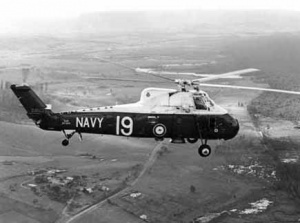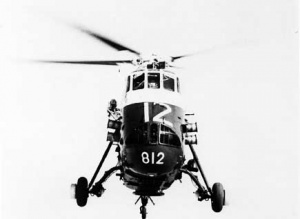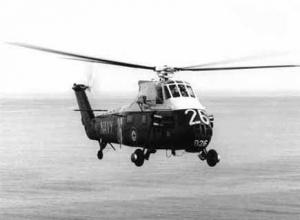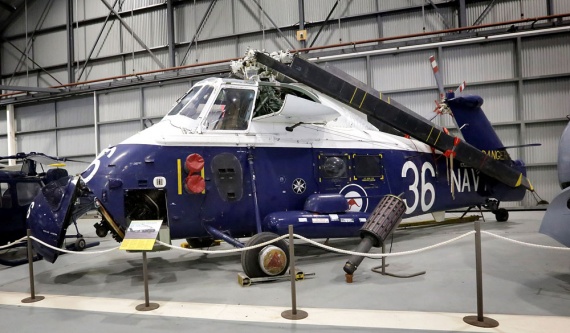Westland Wessex 31B
| Type |
Carrier-borne Anti-submarine/Search and Rescue Helicopter |
|---|---|
| Manufacturer |
Westland Aircraft Ltd, Yeovil, Somerset, UK |
| Number Ordered |
23 |
| First Delivered |
1 November 1962 |
| Last Delivered |
4 November 1963 |
| Length |
65 feet 10.5 inches (38 feet 6 inches with blades and tailcone folded) |
| Height |
14 feet 10 inches |
| Weights | 8000 |
| Dimensions | Wing span: 56 feet (rotors) |
| Speed | 108 knots |
| Range |
262 nautical miles |
| Crew |
4 |
| Engines | One 1600 shp Mk 165C free tubine |
| Performance |
|
| Armament |
Bombs: 2 x torpedoes (external) |
| Ships embarked in |
During 1968-69 a total of 23 of the RAN’s Wessex 31A anti-submarine warfare (ASW) helicopters were upgraded to 31B status and they were to serve the RAN for the next 20 years. The upgrade of the Wessex included fitting the more powerful Mk 165c 1600 shaft horse power Napier Gazelle engines for increased load and performance; a new ASQ-13 sonar; improved navigational aids and radar. The 31Bs could be easily identified from the 31A by the large dorsal hump behind the main rotor. One of the Wessex 31A type was retained in its original configuration for training use and in January 1987 was converted to an instructional airframe.
725 Squadron operated the Wessex for training purposes. They continued to serve operationally in 817 Squadron and were embarked in HMAS Melbourne (II) as ASW helicopters while a few served in Sydney during her logistics and troop transport deployments to South Vietnam, these ending in November 1972.
Melbourne departed Australia in May 1969 for Exercise SEA SPIRIT; a South East Area Treaty Organization (SEATO) exercise. The exercise turned to tragedy when at 0315 on 3 June 1969, Melbourne collided with the American destroyer USS Frank E Evans. The forward section of the destroyer sank and 74 US personnel were killed. Wessex helicopters from Melbourne were used in search and rescue operations following the collision. Lieutenant Commander Des Rogers, 817 Squadron’s Commanding Officer, received the Air Force Cross for his efforts and his leadership of the Squadron on that fateful night. 817 Squadron also received a US Navy Meritorious Unit Commendation. Melbourne returned to Australia in July for repairs and was back at sea in November 1969.
Wessex N7-211 was lost on 13 November 1969 in dramatic circumstances east of Jervis Bay. While conducted a stores transfer to the destroyer HMAS Vampire the helicopter winch cable snagged on a projection on the destroyer’s upper deck. Moments later the ship rolled, and the cable snapped and rebounded into the helicopter’s rotor head, causing the Wessex to ditch. The aircrew were all rescued.
Less than a year later Melbourne was operating in Southeast Asia, for Exercise BERSATA PADU, when Wessex N7-219 ditched off Singapore on 16 June 1970 due to engine failure. The air crew were rescued and the helicopter’s flotation devices keep her afloat. The aircraft was recovered and returned to Nowra where it was used as a training aid. Further bad luck occurred on 23 November 1970 when N7-201, operating from the Naval Air Station - Nowra (NAS-Nowra), ditched in Shoalhaven Bight during a night ‘dunking sonar’ training flight. Again the aircrew were rescued but only one of the Wessex’s flotation devices activated causing the helicopter to capsize and sink while under tow back to the shoreline.
817 Squadron Wessex helicopters were embarked in Melbourne in 1971 when the carrier took part in the first Exercise RIMPAC held in Hawaiian waters. The following year she deployed again for exercises in Southeast Asian waters and again visited Hawaii for Exercise RIMPAC 72. Melbourne took part in Exercise HULA GIRL in Hawaiian waters in 1973 before heading to Southeast Asia for the ANZUK Exercise LEADLINE in November. 1974 saw the carrier deploy to Exercise RIMPAC 74 and then take part in the largest Australian exercise to date, Exercise KANGAROO ONE, in the Shoalwater Bay Training Area.
Wessex N7-208, operating from NAS-Nowra, was lost on 19 November 1974 when it ditched off Beecroft Head, NSW, due to engine failure. Again the crew survived, but only one flotation device inflated on the helicopter causing it to capsize and sink.
A little over a month later, on Christmas Eve 1974, the city of Darwin was devastated by Cyclone Tracy. The RAN’s response was immediate. Melbourne sailed on the 26th with seven Wessex helicopters embarked under the auspices of Operation NAVY HELP DARWIN. During the trip to Darwin the aircraft were used to pick up personnel who had been unable to join their ships before the fleet sailed from Sydney. Melbourne anchored off Darwin on 1 January 1975 and the helicopters went to work immediately moving personnel ashore to carry out clean up duties and transporting over 100 tons of essential stores and equipment.
Following the carrier’s return to Sydney in late January 1975, Melbourne prepared for her next tasking, Exercise RIMPAC 75, in March before commencing a refit in Sydney. RIMPAC 75 was the last major exercise in which the Wessex would be used as an ASW aircraft.
On 6 June 1975 the Director of Naval Aviation Policy announced that 725 Squadron would be decommissioned and that 723 Squadron would become a composite Squadron with the addition of four Wessex helicopters. 817 Squadron would be re-equipped with the new Sea King Mk 50 anti-submarine warfare helicopters which began to embark in Melbourne in mid-1976. The remaining Wessex helicopters were to be placed in storage pending their conversion to a twin-engine utility helicopter. Ultimately the twin-engine conversion plan never eventuated and the Wessex continued to serve in 723 Squadron as a single-engine training aircraft and also provide a search and rescue capability both on-board Melbourne and from NAS-Nowra.
In 1977 Melbourne deployed to the United Kingdom for the Silver Jubilee celebrations for Queen Elizabeth II. This included a fleet review at Spithead followed by participation in Exercise HIGHWOOD in the North Atlantic Ocean to the east of the Faroe Islands. During this exercise Wessex N7-213 ditched on 13 July while conducting plane guard duties while Melbourne was launching A4 Skyhawks. The four air-crew were rescued by the destroyer HMAS Brisbane, also part of the Jubilee deployment, and the damaged Wessex eventually recovered and craned on board Melbourne. The aircraft was returned to Australia but never repaired.
On 22 January 1978 another Wessex was lost when N7-212 ditched near Bowen Island while flying from NAS-Nowra to Melbourne. The aircrew swam ashore and the wrecked aircraft was towed ashore at Murrays Beach, Jervis Bay. The Wessex was later moved by a RAAF Chinook helicopter, as an underslung load, back to NAS-Nowra where it was stored and not repaired. This airframe was amongst those disposed of in 1989.
With Melbourne decommissioned in mid-1982 the Wessex were embarked as required in the destroyer tender HMAS Stalwart, the landing ship heavy HMAS Tobruk and, from 1986, the tanker HMAS Success. During these periods the helicopters were used in the utility role moving personnel, stores and equipment. The size of the Wessex prevented it from being embarked in the Adelaide Class frigates.
The only fatal crash of a Wessex occurred in December 1983. Since 1980 the ADF had conducted patrols and counter-terrorism exercises in the vicinity of the Bass Strait oil rigs due to concerns by the Australian Government concerning these vital national assets. Several Wessex helicopters were based at RAAF Base East Sale, Victoria, conducting personnel transport duties to and from the oil rigs and supporting SAS training exercises. On 4 December 1983 Wessex N7-217 departed East Sale with a three man crew on its second sortie of the day to collect a five man RAAF medical team from the oil rig ‘Marlin Platform’. About 13 minutes after departing the oil rig the pilot (Lieutenant Mark Henschke, RAN) noticed an unusual and increasing vibration through the helicopter. He declared an emergency at 1206 and descended from a cruising altitude of 1000 feet to approximately 100 feet. He reduced speed with the intent of making an emergency landing at Golden Beach, a small settlement on 90 Mile Beach, Victoria, which was then some 50 kilometres away. At 1212 the air traffic controllers at East Sale heard a further call from Henschke to the control tower at the Longford oil and gas plant stating that the vibrations were worse and that contact had been lost with East Sale due to the low altitude. This was the last transmission received and the Wessex crashed into the sea at approximately 1213; only two kilometres from Golden Beach.
The Longford search and rescue helicopter, a float-equipped Bell 205, was immediately launched and at 1234 sighted an oil slick approximately two Kilometres off Golden Beach. The helicopter landed on the water and rescued six survivors who were then transferred to RAAF Base East Sale. The search continued for the two missing personnel (Leading Aircrewman Gary Macey and RAAF Corporal James Campbell) but no trace of the men was found. It was not until the wreckage of the helicopter was recovered, from 20 metres of water, by a specialised offshore support vessel that the bodies of both men were recovered from within the upturned helicopter.
An inquiry into the cause of the crash cited failure of the input drive bevel gear in the transmission casing due to a fatigue crack. This crack appears to have originated in a metallurgical defect developed during its manufacture. On failing, the drive was ejected though the transmission casing which also provided support for the port swash-plate control servo. With no support, the servo dropped towards the floor of the transmission bay causing the aircraft to pitch and roll rapidly and assume an uncontrollable nose down aspect. Henschke stated that the Wessex was nose low and almost inverted when it struck the water; he was subsequently awarded a Chief of Naval Staff Commendation for his airmanship in a highly dangerous situation.
As a result of this crash all Wessex helicopters were grounded while a full inspection of all aircraft took place. For those helicopters not at Nowra this required them to be returned by a novel means. A RAAF Chinook heavy lift helicopter was used to lift the smaller Wessex helicopter, as an underslung load, onto the deck of Tobruk. Once they were embarked, Tobruk sailed to Jervis Bay where a Chinook lifted the smaller helicopters off and flew them to NAS-Nowra. Once the inspection was completed the aircraft were returned to flying duties.
Wessex N7-209 ditched on 31 May 1987 due to engine failure off Bondi Beach, NSW, while en route to Rockhampton for exercises with USS Midway. Her three man crew and three aircraft maintainers were rescued and the Wessex remained afloat for 45 minutes until one of the flotation bags burst causing the aircraft to capsize. The helicopter was towed to Botany Bay by HMAS Curlew where it was landed and returned by road to Nowra. 209 was stripped for spare parts and ended her days on the Nowra fire ground as a training aid.
On a more positive note two Wessex helicopters were embarked in Success during Operation MORRIS DANCE in Fijian waters in mid-1987. This operation was the first major deployment for Australian forces since the Vietnam War; resulting from a military coup in Fiji on 14 May 1987. HMA Ships Adelaide, Cessnock, Dubbo, Parramatta, Stalwart, Success, Sydney, Tobruk, Townsville and Wollongong (and two Royal New Zealand Navy frigates) were deployed at various stages during the operation in order to evacuate Australian citizens, and other approved foreign nationals, if required. HMAS Jervis Bay sailed on 2 June to join the task group but the operation ceased soon after and the RAN units returned to Australia. The two Wessex helicopters in Success conducted significant logistics resupply, moving provisions and stores to other ships in the task group to keep them on station until relieved or ordered to return to Australia.
1989 was the last year of service for the venerable Wessex with her role at sea as a utility helicopter subsumed by the Squirrel, Kiowa and Sea King. Two more Wessex helicopters were lost during their final months of service. On 8 August 1989 N7-202, embarked in Success for Exercise KANGAROO 89, was operating north of Darwin conducting a logistics resupply to other ships in the task group. The helicopter had landed on Success and was preparing to depart with an underslung load when it began to shake uncontrollably due to ground resonance. The aircrew began to shut the helicopter down but the excessive vibrations caused the left hand undercarriage to collapse and all blades to strike the deck. The Wessex was badly damaged and was subsequently donated to the Darwin Aviation Museum rather than be returned to Nowra for repair.
Then on 30 October 1989 N7-218, embarked in Stalwart, ditched in the Java Sea due to engine failure; all five aircrew were rescued by Stalwart’s crash boat. The helicopter was recovered but not repaired and, upon its arrival at NAS-Nowra, was sent to the fire ground as a training aid.
The surviving 13 Wessex 31Bs were withdrawn from service in late December 1989. Some were subsequently used for fire-fighting training at NAS-Nowra but many found their way into aviation museums. Examples of the Wessex can be seen in various aviation and maritime museums in the Northern Territory, Queensland, New South Wales, Victoria and South Australia.











